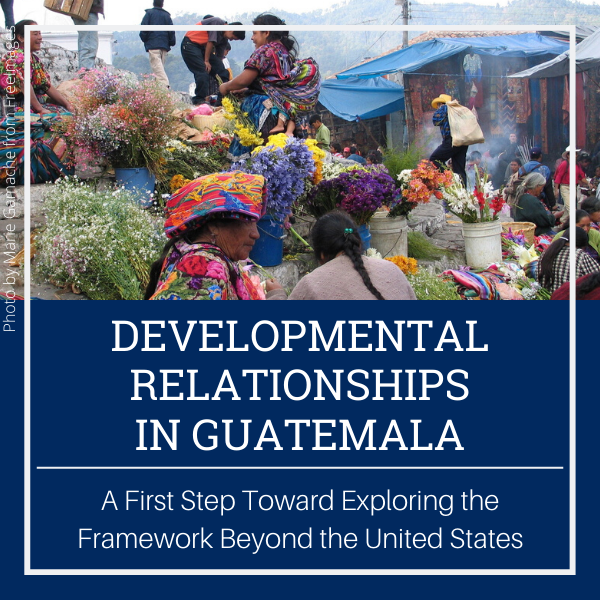Blog
Developmental Relationships in Guatemala: A First Step Toward Exploring the Framework Beyond the United States

Developmental Relationships in Guatemala: A First Step Toward Exploring the Framework Beyond the United States
By Peter C. Scales, Ph.D., Eliel Gebru, and Maura Shramko, Ph.D.
Search Institute has almost 15 years of experience measuring Developmental Assets® in more than 30 countries around the world. However, we haven’t had the opportunity to explore whether and how our work on developmental relationships might resonate in contexts and cultures beyond the United States.
Until now. In 2019, with support from USAID, World Vision Guatemala engaged Search Institute to develop and test a survey to assess youths’ positive developmental resources, including developmental assets and developmental relationships, in relation to young people’s experiences of migration out of Guatemala and community violence. This pilot survey provides our first preliminary data based on the developmental relationships framework outside of the United States.
The Measure We Developed
The survey, which was administered in Spanish in collaboration with local leaders, was based on a brief measure of developmental relationships that is made up of single items measuring each of the five core elements of developmental relationships in families: Express Care, Challenge Growth, Provide Support, Share Power, Expand Possibilities. Based on themes raised by Guatemalan youth in focus groups and interviews, we added two new items for this study:
“How often do your (grand) parents provide money to help you pay for school?” and
“How often do your (grand) parents teach you to stay away from bad people or things like drugs or alcohol?”
We assessed the scientific quality of these measures (how consistent and stable the responses were), and found that they met standards for being acceptable to use, though like any measures they can be improved over time as they are used.
Extent of Developmental Relationships in the Family
The results show how a sample of 198 youth ages 13-18 in Guatemala viewed relationships with their parents and grandparents. (For the field test, youth were asked to consider not only their parents and grandparents, but also any other adult who acted as their caregiver, a common situation in our sample.) Figure 1 shows the results in terms of total developmental relationship scores.

Scores of 25-30 on these measures mean that youth are experiencing excellent relationships that consistently provide them with the five elements of developmental relationships.
The scores for the pilot sample of Guatemalan youth are in the next lower level, suggesting good relationships that often provide those five elements. The scores for grandparents are a bit lower, but still, they suggest mostly good relationships that sometimes-to-often provide the five elements. The quality of youth-reported developmental relationships is important because higher quality is associated with more positive youth outcomes (Pekel et al., 2018; Roehlkepartain et al., 2017; Scales et al., 2019).
The Elements of Developmental Relationships
Figure 2 shows the results in a different way, by displaying the percentage of youth who said each element of the framework occurs rarely or never, sometimes, often, or always.
Youths’ responses on the elements indicated that the majority were frequently experiencing strong relationships within their families, as the total score suggested.
Even so, some areas were apparent where improvement in family relationships could be promoted. About 40% of the youth said parents, grandparents, or the people who took care of them rarely or only sometimes helped them get things done (43%), listened to their ideas and took them seriously (42%), or connected youth to new people, places, or ideas (40%).

Developmental Relationships and Youth Outcomes
The sample was small, so these are just very preliminary findings. But we did find that youth with higher levels of developmental relationships were significantly less likely to have been in a fight, compared with youth who had lower relationship scores. This was true for both the original and expanded developmental relationships measures. In addition, although not reaching statistical significance, greater reporting of having developmental relationships in their lives was linked to youth reporting lower levels of having hurt someone or intention to migrate from Guatemala in the next year. These early results are worth investigating further with a larger sample.
Conclusion
Youth reported overall good (but not excellent) developmental relationships from both parents and grandparents, with the relationships quality with grandparents being slightly lower. Actions that could be strengthened included more often providing support to help youth get things done, listen to their ideas and take them seriously, and connect youth to new people, places, or ideas.
Few youth reported engaging in violent behavior, or having intentions to migrate from Guatemala in the next year, making it difficult to expect the level of developmental relationships to show significant associations with those behaviors. Nevertheless, youth with higher development relationships scores were significantly less likely to report having been in a fight in the past year. Although not statistically significant, youth with higher developmental relationships scores also reported less hurting of someone or likelihood of migrating in the next year.
This small pilot study only looked at developmental relationships in the family, and only at young people’s relationships with parents, grandparents, and other caregivers. So this research outside the United States needs to be expanded, not just to larger samples, but to include other family such as siblings, and relationships outside the family, including friends, teachers, adults in youth organizations, and those in community. As we study developmental relationships in other non-U.S. settings, we’ll also likely understand a lot more about how relationships get cultivated in various settings, in ways that perhaps might not be as common in but still have lessons for the U.S., especially from cultures that have a more collectivist than individualistic tradition. International research broadened understanding of how the developmental assets approach is more or less culturally valid and gets applied in different cultures. In the same way, the Guatemala study is a first step down the path of understanding better how developmental relationships may have strong relevance and practical value, and yet be expressed and built in diverse ways around the world.
References
Pekel, K., Roehlkepartain, E.C., Syvertsen, A.K. Scales, P.C., Sullivan, T.K., & Sethi, J. (2018). Finding the fluoride: Examining how and why developmental relationships are the active ingredient in interventions that work. American Journal of Orthopsychiatry, 88(5), 493-502. doi:10.1037/ort0000333
Roehlkepartain, E.C., Pekel, K., Syvertsen, A.K., Sethi, J., Sullivan, T.K., & Scales, P.C. (2017). Relationships first: Creating connections that help young people thrive. Minneapolis: Search Institute (www.search-institute.org/relationships-first).
Scales, P.C., Pekel, K., Sethi, J., Chamberlain, R., & van Boekel, M. (2019). Academic year changes in student-teacher developmental relationships and their linkage to changes in middle and high school students’ motivation. Journal of Early Adolescence (in press). DOI: 10.1177/0272431619858414
Scales, P.C., Roehlkepartain, E.C., & Shramko, M. (2017). Aligning Youth Development Theory, Measurement, and Practice across Cultures and Contexts: Lessons from Use of the Developmental Assets Profile. Child Indicators Research, 10(4), 1145-1178 (published online May 2016). DOI 10.1007/s12187-016-9395-x
Üstun, T. B., Chatterji, S., Mechbal, A., & Murray, C. J. L. (2005). Quality assurance in surveys: standards,guidelines, and procedures. In United Nations Department of Economic and Social Affairs (Ed.), Household sample surveys in developing and transition countries (pp. 199–230). New York: United Nations Department of Economic and Social Affairs. Retrieved from http://unstats.un.org/unsd/hhsurveys/pdf/Household_surveys.pdf.

